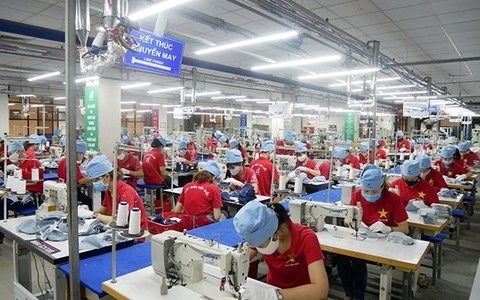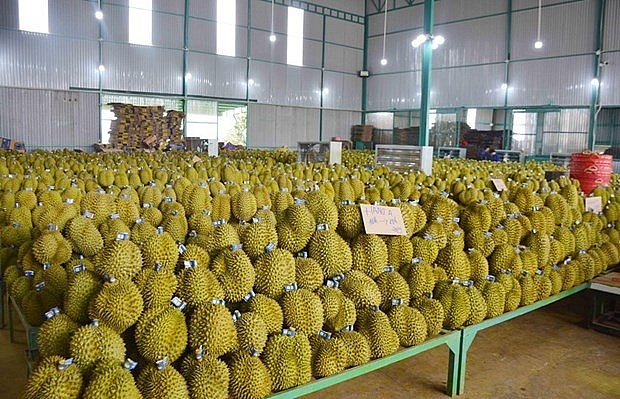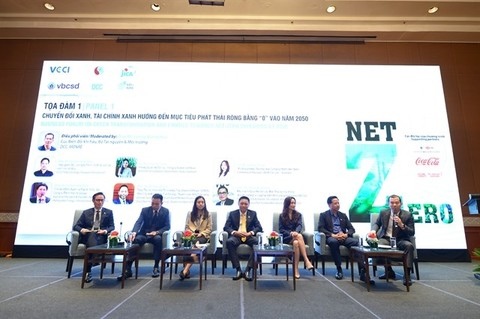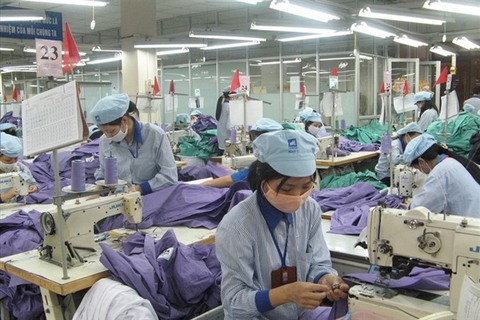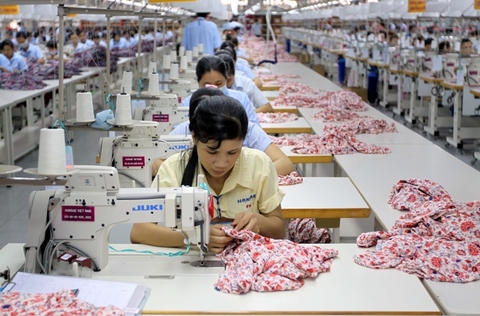WEF drives Vietnam to an Industry 4.0 future
WEF drives Vietnam to an Industry 4.0 future
Boasting great growth potential, a favourable geographical location, and a large network of free trade agreements, Vietnam is emerging in the region as a key player, majorly attractive to foreign investment. This week’s World Economic Forum on ASEAN 2018 in Hanoi shows how the country can harness digital disruption for its future development in the era of Industry 4.0.

At a recent Industry 4.0 summit in Hanoi, Ousmane Dione, World Bank country director for Vietnam, captivated hundreds of participants by talking about a device – one which is not very special, as it is used by millions of people in the country.
“As you sit in the audience, you may even be looking at it right now. You have probably guessed by now, I am referring to our smartphones,” he said.
Back in 1983, Dione said, one could only make mobile calls with a Motorola DynaTAC 8000x, which had a height of 33 centimetres and weighed 800 grammes. In contrast, the iPhone 6 weighs about 16 per cent of its distant cousin’s weight from 35 years ago, but is exponentially more useful.
For example, he explained, the World Bank is supporting an initiative that allows farmers to use smartphones, paired with an automated sensor in the field, to monitor the level of water in their rice paddies. When the water level gets low, the farmer can use a smartphone to trigger the pumping station. The farmer can monitor multiple plots and sensor stations at once, from a distance. This has implications for agricultural productivity, water conservation, greenhouse gas reduction, and rural development in Vietnam.
“Technological convergence has changed the way we live, work, produce, and consume. Sometimes this change is gradual, but it can also be disruptive. If we can truly predict one thing in this era of rapid and exponential technological change, it will be continued disruption across different dimensions,” Dione said.
High growth potential
Recently, the World Bank issued its latest forecast of Vietnam’s economic growth, which is expected to be 6.8 per cent this year – up from 6.5 per cent in the bank’s previous projection, largely thanks to a recovery in foreign direct investment (FDI) and the performance of domestic private firms, in addition to a cyclical increase in global demand.
US-based Trading Economics, which provides over 20 million economic indicators for 196 countries, forecast Vietnam’s GDP growth rate to reach 8.4 per cent by the end of this quarter, far higher than the government’s expectation of 6.7 per cent. “Looking forward, we estimate the rate to stand at 8.5 per cent in 12 months’ time,” said a bulletin released by the firm two weeks ago.
Moody’s Investors Service also upgraded the Vietnamese government’s long-term issuer and senior unsecured ratings to Ba3 from B1 and changed the outlook to ‘stable’ from ‘positive.’
“The upgrade to Ba3 is underpinned by strong growth potential, supported by increasingly efficient use of labour and capital in the economy,” Moody’s said in a statement released on its website.
Over the past many years, Vietnam has also boosted negotiations and signings of several free trade agreements. To date, the country has joined 16 bilateral and multilateral FTAs. Thus, it is clear that, along with its increased international integration via new FTAs and its improved business climate, skilled workforce, and large consumption market of over 93 million people, Vietnam currently boasts ideal conditions to become a major economic hub in the region.
As of August 20, Vietnam had 26,438 valid FDI projects, registered at $333.84 billion. In this year’s first eight months, total disbursed FDI hit $11.25 billion, up 9.2 per cent on-year.
Opportunities
However, a question has been posed: Amid Industry 4.0’s rise, how can Vietnam leverage its strengths to boost sustainable growth?
The World Economic Forum on ASEAN 2018 (WEF ASEAN 2018), which is themed “ASEAN 4.0: Entrepreneurship and the Fourth Industrial Revolution” and scheduled to take place in Hanoi on September 11-13, will present attendees with new business opportunities in Vietnam.
“The event will provide great lessons and experience for Vietnam to turn itself into a digital economy,” said Vu Tien Loc, chairman of the Vietnam Chamber of Commerce and Industry. “The event will offer opportunities for Vietnam to receive words of wisdom to boost socio-economic development, based on exploiting its great potential in the era of Industry 4.0.”
Justin Wood, head of Asia Pacific and member of the Executive Committee of the WEF, told VIR that Industry 4.0 affects all countries, from the richest and most modern to the poorest and least developed. However, new technologies will bring about different impacts in different countries, which is the subject of study.
“The era of new technologies has posed major policy questions, and the WEF ASEAN will provide an opportunity for Vietnam to discuss and understand better the steps to be taken next,” Wood said.
For the first time in the history of the WEF, a business summit – the Vietnam Business Summit (VBS) – will be organised as an important part of the forum. It is expected that about 1,200 Vietnamese and international delegates will attend the VBS, which is themed “Vietnam: We mean business”.
Notably, the VBS will be chaired by Vietnam’s Prime Minister Nguyen Xuan Phuc and the WEF’s president Borge Brende. The summit’s discussions will focus on the role of Vietnam in regional and global value chains, as well as introduce policies and business and investment opportunities in the country.
“The organisation of the VBS means that Vietnam’s role and position on the international stage have been highly valued,” Loc said. “The country is emerging as a bright spot in the world’s economy, the business and investment climate of which is significantly improving in favour of enterprises and people.”
Harnessing disruption for further development
According to Vietnam’s Ministry of Information and Communications, as of late June 2018, Vietnam had about 136 million mobile phone subscribers. Some 54.2 per cent of the country’s population are using internet. Still, currently, in terms of digital adoption, Vietnam shows strengths and shortcomings. The World Bank’s Development Report 2016 on Digital Dividends ranks Vietnam’s Digital Adoption Index at 0.46 on a 1-point scale. While higher than the average of global lower middle-income countries, it is lower than the regional average.
Internet penetration is 54 per cent, and 40 per cent of Vietnam’s population are social media users. These numbers are impressive, according to the World Bank in Vietnam.
Dione said that in order to forge ahead or even leapfrog regional peers, Vietnam must upgrade the way its government functions. “Three types of government relationships are
critical: government-to-government, government-to-business, and government-to-citizens. Technologies can help in many ways if we can embrace them strategically to reverse potential disruptions to these relationships.”
Dione expressed his belief that a three-factor formula, or a tripod, is necessary for Industry 4.0 to really help Vietnam achieve its development aspirations: technologies, institutions, and people. Investing in research and development will be critical for Vietnam in order to join the frontiers of Industry 4.0. “Made in Vietnam” should be replaced with “Researched and developed in Vietnam”, Dione stressed.
“Let’s return to our smartphones. Perhaps you are a public official and you were using your smartphone to look up social assistance coverage of poor and near-poor people in the northern mountainous region? With an integrated national database linked by a unique ID system, you could do this whether you are at your office desk or at the Industry 4.0 Summit. Perhaps you are a business person who needed to bid for government auctions or file taxes on your phone? Or perhaps you were sending instructions to a relative in a remote area who needs to pay her electricity bill by phone? I believe this is the future of Vietnam,” Dione said.
“But whatever you do, let us not undermine the basis. For Industry 4.0 to serve Vietnam, the government must first ensure an enabling environment to accommodate innovation and improve productivity. This includes macro stability and resilience, and the effective and efficient use of fundamental technologies of Industry 3.0.”
He suggested a T.I.P approach to realise this future: leveraging Technologies to capitalise on innovations; putting in place fundamental Institutions; and investing in the People of today and the future.


